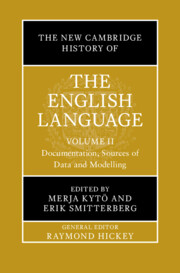Book contents
- The New Cambridge History of the English Language
- The New Cambridge History of the English Language
- The New Cambridge History of the English Language
- Copyright page
- Contents
- Figures
- Tables
- Contributors to Volume II
- General Preface
- Abbreviations for Corpora and Other Electronic Resources
- General Editor’s Introduction
- Introduction to Volume II
- Part I The Textual Record
- Part II Lighthouse Works and Authors
- Part III Genre and Medium in the Record
- Part IV Modelling the Record: Methods and Theories
- 27 Quantitative Methods and the History of English
- 28 Generative Accounts of Change
- 29 Functional Accounts of Change
- 30 Grammaticalisation
- 31 Cognitive Approaches to the History of English
- 32 Construction Grammar and English Historical Linguistics
- 33 Psycholinguistic Perspectives on Language Change
- Appendix: List of Corpora and Other Electronic Resources
- Index
- References
31 - Cognitive Approaches to the History of English
from Part IV - Modelling the Record: Methods and Theories
Published online by Cambridge University Press: 18 October 2025
- The New Cambridge History of the English Language
- The New Cambridge History of the English Language
- The New Cambridge History of the English Language
- Copyright page
- Contents
- Figures
- Tables
- Contributors to Volume II
- General Preface
- Abbreviations for Corpora and Other Electronic Resources
- General Editor’s Introduction
- Introduction to Volume II
- Part I The Textual Record
- Part II Lighthouse Works and Authors
- Part III Genre and Medium in the Record
- Part IV Modelling the Record: Methods and Theories
- 27 Quantitative Methods and the History of English
- 28 Generative Accounts of Change
- 29 Functional Accounts of Change
- 30 Grammaticalisation
- 31 Cognitive Approaches to the History of English
- 32 Construction Grammar and English Historical Linguistics
- 33 Psycholinguistic Perspectives on Language Change
- Appendix: List of Corpora and Other Electronic Resources
- Index
- References
Summary
This chapter explores the role of central aspects of cognition in historical linguistics. After describing and discussing the cognitive commitment and its theoretical background, this chapter highlights the relation to cognitive archaeology as well as historical psychology and explores the methodological prerequisites for cognitive approaches to the history of English, particularly the quantitative turn in cognitive linguistics. Case studies from different periods of English illustrate how cognitive factors can shed light on synchronic historical language stages and diachronic developments, and how these in turn can help us to further explore the cognitive commitment. Finally, we argue for a feedback loop, where modern cognitive linguistic theories feed into and guide historical enquiries, but are also checked and modified, if necessary, on the basis of historical findings.
Keywords
Information
- Type
- Chapter
- Information
- The New Cambridge History of the English LanguageDocumentation, Sources of Data and Modelling, pp. 768 - 795Publisher: Cambridge University PressPrint publication year: 2025
References
Accessibility standard: WCAG 2.0 A
Why this information is here
This section outlines the accessibility features of this content - including support for screen readers, full keyboard navigation and high-contrast display options. This may not be relevant for you.Accessibility Information
Content Navigation
Allows you to navigate directly to chapters, sections, or non‐text items through a linked table of contents, reducing the need for extensive scrolling.
Provides an interactive index, letting you go straight to where a term or subject appears in the text without manual searching.
Reading Order & Textual Equivalents
You will encounter all content (including footnotes, captions, etc.) in a clear, sequential flow, making it easier to follow with assistive tools like screen readers.
You get concise descriptions (for images, charts, or media clips), ensuring you do not miss crucial information when visual or audio elements are not accessible.
Visual Accessibility
You will still understand key ideas or prompts without relying solely on colour, which is especially helpful if you have colour vision deficiencies.
Structural and Technical Features
You gain clarity from ARIA (Accessible Rich Internet Applications) roles and attributes, as they help assistive technologies interpret how each part of the content functions.
